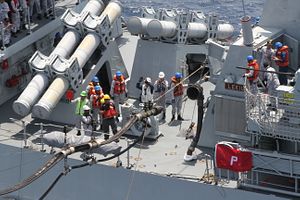This week, Malaysia’s navy chief confirmed that the Southeast Asian state would for the first time send a warship to fully participate in this year’s iteration of the Rim of the Pacific (RIMPAC) exercises, the world’s largest international maritime exercise.
Malaysia’s involvement in RIMPAC, which takes place biennially in the summer months in waters around the Hawaiian Islands and southern California, is not new. It has previously participated in the exercises, and even before that, it, like some other countries, had sent observers to the drills in past iterations in a small scale.
But there had been indications ahead of RIMPAC 2018 that Malaysia would be deploying a warship this year for the first time. For instance, earlier this month, when Military Sealift Command’s dry cargo and ammunition ship USNS Washington Chambers conducted an underway replenishment with the Royal Malaysian Navy’s KD Lekiu, the engagement was publicly billed by the U.S. Navy as a means to allow the ship to increase its range and transit further east in support of RIMPAC 2018 later this year.
This week, in further confirmation of this, Admiral Ahmad Kamarulzaman Ahmad Badaruddin, the commander of the Royal Malaysian Navy (RMN), confirmed that Malaysian warship KD Lekiu would be away for three months for activities related to RIMPAC. “This is the first time the ship and its crew of 27 will be participating in RIMPAC for three months,” local media outlets reported Kamarulzaman as telling an audience at the Defense Services Asia (DSA) Exhibition and Conference and National Security Asia (Natsec) 2018 at the Malaysia International Trade and Exhibition Center.
Malaysia’s expansion of its role in RIMPAC is far from surprising. Malaysia already participates in several bilateral and multilateral exercises involving the United States (See: “The Real Test for US-Malaysia Relations in the Trump Era”). It has also been receptive to expanding the extent of its involvement in some of those drills over time, even as it remains open to such opportunities with other countries as well, including newer partners like China (See: “Malaysia’s New China Warships Deal: Promises and Prospects”).
Kamarulzaman did not publicly disclose additional specifics about Malaysia’s participation. But he framed Malaysia’s participation at RIMPAC 2018 as an illustration of the RMN’s commitment to defense diplomacy and enhancing interoperability of its assets, especially given the role of the exercises within the broader context of the regional and global maritime space.
The KD Lekiu is expected to set sail next month and join 51 vessels and five submarines for RIMPAC 2018. As that occurs, it will be interesting to see how the shape of Malaysia’s participation plays out at RIMPAC 2018, as well as in the iterations that follow.

































